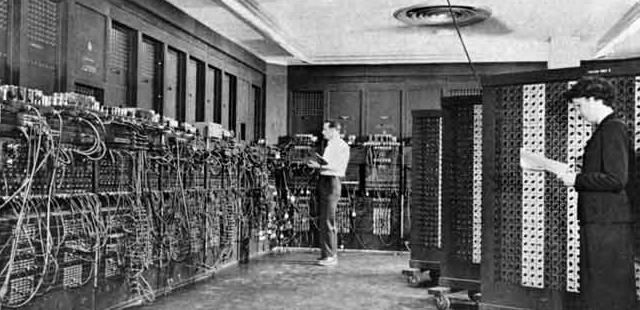Ross Perot is a collector. He once bought a copy of the Magna Carta in 1984. But, more intriguingly, he also bought and resurrected ENIAC, the world’s first electronic computer.
ENIAC stands for the “Electronic Numerical Integrator And Computer” and was conceived of during World War II to help calculate the arched paths of artillery bullets. It is an absolutely massive machine weighing in at 25 tonnes and occupying 167sqm when fully assembled. Construction began in 1943, but by the time it was finished in 1945, the war was over. The US Army kept a tight lid on things at first. Even the maintenance manual (below) remained classified until 1946. So what did the United States Army do with this marvel of technology? They used it to design the first hydrogen bomb. Then, in 1955, they threw the thing away.

ENIAC panels on display at the Smithsonian.
Back in 2006, the data business pioneer and former presidential candidate asked his staff to deck the halls of Perot Systems with history’s most interesting computers. And since ENIAC is to computing history what the Magna Carta is to legal history, that became the piece to have.
After it was decommissioned, ENIAC was broken up into 40 panels which were basically lost in random warehouses due to poor record-keeping. Libby Craft, Perot’s director of special projects, ultimately set out to track down as much of it as she could and found nine panels stored at Oklahoma’s Fort Sill. Officials at the base didn’t even know how they ended up with several tons of computing history, but they did agree to let Perot Systems borrow eight of the panels in exchange for restoring them.
ENIAC was too abused and broken to actually process information, but Perot’s staff rigged up a motion-sensor situation that would make the panel lights blink as people walked by. (Don’t forget: the world’s first computer wasn’t all that very powerful in the first place.) Since Perot kept his company on pretty strict lockdown, however, not that many visitors got to see it.
Thankfully, Perot’s ENIAC panels found their way back to Fort Sill last month. (The Smithsonian has a few panels too.) There, it’s on display at the US Army’s Field Artillery Museum, where visitors can view the massive machine and its blinking lights — for free. [Wired]

Pictures: Flickr
